Several years ago, now, confronted with yet another friend whose spouse was dying of cancer, I asked myself, “Why are our cancer rates so high? Isn’t there anything we can do to stop cancer?”
This wasn’t a hypothetical question. I really wanted to know why we went from a cancer rate of 1 in 100 in 1900 to 1 in 3 women and 1 in 2 men in 2010 (I don’t know now where I got those statistics–I just memorized them for a presentation I was doing at the time).
I never bothered to figure out the answer, until I happened to pick up a book with an intriguing title last week, and had boxes of evidence, and the answer to how to stop cancer, dumped over my head.
But first, a detour. At the beginning of this year, I read another book and changed my habits, as I so often do. I read the book Blue Zones Kitchen by Dan Buettner and was super inspired to eat more vegetarian meals.
We started eating that way at the beginning of the year, but then Covid hit, and we quietly put vegetarian eating aside and went back to our typical fare. No big deal. We eat pretty healthy. Healthy proteins, like eggs and chicken, some sausage and bacon, but not a ton, veggies, like kale, carrots, sweet potatoes, tomatoes, pasta.
Eating vegetarian is good, I vaguely knew, but so much had happened since I read that book, that I just couldn’t remember why it was worth the trouble, especially during a global pandemic.
So when I picked up this latest book, with lots of leafy greens on the cover, provocatively entitled How Not to Die, I didn’t really know what I was getting into. I actually had no idea what the book was about. It was in my Kindle Unlimited picks, so I dived in.
Turns out, the book finally answered the question I’d asked myself back in my 30s. I honestly didn’t think there was a clear answer to why cancer rates had increased so much in this country, just thought it might vaguely have something to do with increased toxins in our groundwater.
But the author, Michael Gregor, MD, has made it his life mission to collect as many double-blind, placebo-controlled (etc.) top-flight studies as possible to figure out how to reduce various types of diseases, including cancer, that kill us.
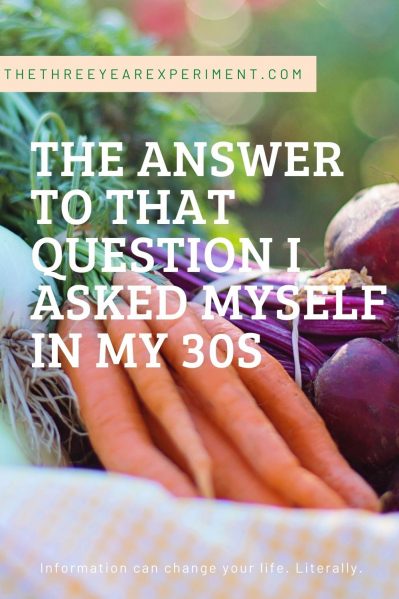
First off: heart disease. You know that’s the number-one way people in this country die, right? Heart disease is no less than an epidemic in this country. Almost 400,000 people each year die from heart disease. Uhm, that’s even more lives than Covid has taken, and we’ve completely shut down everything for Covid. But, it tends to be something that happens to older people, so I’ve never really worried about it, because I have low blood pressure. But, Mr. ThreeYear has had high blood pressure and has even taken statins in the past to lower his blood pressure.
When he had high blood pressure, you know what his doctor told him? “Take this medicine (blood pressure medicine), without fail, for the rest of your life.” He was like 35 when his doctor told him this.
Did you know what his doctor didn’t tell him? “Lose some weight, buddy, because you’re fat.” (Spoiler alert: the book does not tell you to lose weight as the way not to die–phew!).
Coronary heart disease is caused by “fatty deposits in the walls of your arteries called atherosclerotic plaque. … This buildup of plaque, known as atherosclerosis… is the hardening of the arteries by pockets of cholesterol rich gunk that builds up within the inner linings of the blood vessels.”
How do those fatty build-ups happen? They aren’t just a by-product of getting old or bad genetics (although those factors do play in). Studies have been done on populations around the world whose incidence of heart disease are drastically lower than ours in the US. And, they’ve done studies that show that when these individuals move from their home countries to the US, their rates of heart disease increase, proving it is not just DNA at work.
What the heck is going on?
Turns out, these populations with super-low levels of heart disease have one thing in common: their diet. They eat plant-based, with lots of whole grains and vegetables. Their levels of animal-fat consumption are very low.
I kept reading, chapter after chapter, about how not to die from lung disease, brain disease, infection, high blood pressure (important!), liver disease, blood cancers, etc., etc. The author presented scientific evidence in the form of scientific studies published in such journals as the Lancet, JAMA, and the New England Journal of Medicine, tomes that lined the walls of my dad’s office (he’s a pediatrician) when I was a little girl.
Plants? Who knew?
That is not a facetious question. I really did not know that lowering your consumption of meat, all meat, including fish and CHICKEN, for goodness’s sake, could lower rates of heart disease and cancer.
Let me just say that Mr. ThreeYear and I were ONE DAY IN to a Keto experiment. My sister and brother-in-law had successfully dropped a bunch of weight on Keto, and we decided, grudgingly, to give it a go.
I ate Keto for one day, started reading this book, and did an about-face.
The author makes claims that organizations in this country have been afraid to make publicly. He does it in such a sophisticated way that you don’t feel bullied into it. He presents you with mountains of scientific data that essentially leads you to a clear choice–
Eat 100% plant-based.
Ok, now, my caveat: I just said, to my sister, not three months ago, that I was someone who would never go vegan. Guys, I apologize in advance for this statement, but here it is:
I have never felt bad about eating living things. I don’t cry or feel tender when I eat veal, one of my favorites. I don’t watch tragic videos from slaughterhouses and weep or eschew leather. I love to eat meat. I love to wear leather.
Sorry. But I am just not that soft-hearted towards animals.
But cancer? I HATE cancer. I do not want to get cancer. If you hit me over the head with a macktruck-sized-load of evidence that says I can drastically reduce my chances of getting cancer, and perhaps more importantly, can drastically reduce my husband’s and kids’ chances of getting cancer, by eating plant-based?
I am freakin’ in.
I have no ethical reason for cutting meat and dairy out.
But when I learned that chicken and eggs can increase my rate of several different types of cancer? I thought chicken and eggs were good for my body. I feel lied to.
We have been.
Lobbying groups have a powerful incentive to keep us eating what we are currently eating.
I truly didn’t know that you are better off, and I mean, scientifically-proven-better-off, not eating eggs, chicken, dairy.
So, now that I have been presented with this information, with the answer to the question I asked myself back in my 30s, what do I do with it?
My family can predict: I will go really hard plant-based for a month or two, then go back to my normal ways of eating.
But, I honestly don’t want to do that. I can tell this way of eating is good for me.
Gross paragraph alert: skip this if GI talk makes you cringe. The one day that I was on the Keto diet, my poop totally changed. After one day. It was hard and small. Since I have been eating brown rice, sweet potatoes, chickpeas, kale, broccoli, etc., over these past few days, my poop looks completely different. It’s abundant and soft (I know, so gross). I learned in this book that when you feed your good flora with plants, legumes, and whole grains, you actually have larger poops because your poop is mostly bacteria. Yep. My body is apparently super sensitive to that.
I’ve been talking to my kids and Mr. ThreeYear about what I’ve been reading and learning. They have been surprisingly on-board with changing the way we eat.
But also, we are all trying to be realistic. Stuff we are not giving up, but are going to keep to special occasions: ceviche (Junior ThreeYear and Mr. ThreeYear’s favorites), sashimi (my favorite) and bacon (Little ThreeYear’s favorite).
Last night we had Annie’s mac ‘n cheese made with milk and butter.
But, we ate it with broccoli and greens. And we ate Indian chickpeas (Chana Masala), brown rice, veggie charquican (a Chilean soup made with pumpkin and beans), and salad for other meals over the weekend.
Junior ThreeYear picked out some wild-caught salmon and made the excellent point, “It’s better for me to eat this and rice for lunch than tortilla chips.” And he’s right. He will default to chips if his lunch is something he doesn’t like, so salmon is a much better choice than chips.
Eating is a HUGELY personal choice. It is the most personal choice. And food is intrinsically tied in with emotion. That’s why the most enduring legacy of immigrants to this country is their food. You can lose your language but not what you eat! So talking to people about eating something different than what they have always eaten is FRAUGHT. I know that.
I also know that I have never heard before that eating only plants will help my health that much. I thought that eating lean meats was fine, and even good for you, as long as you were eating lots of plants, too.
But listen to this:
I’m not telling you to change your diet. I am telling you that my family was convinced, through scientific evidence, NOT to go Keto and to instead try plant-based. It doesn’t mean we never again eat meat or dairy (obviously–we’ve been eating it for 46, 41, 13, and 10 years, respectively). So we are going to work hard at changing the way we eat. We are going to come up with some basic recipes we can make and enjoy.
We love lentils, so that is in.
We are huge fans of Indian food, and I have always wanted to know how to make Palak Paneer, so I am going to try it with tofu. I already tried Chana (Chickpea) Masala and it was great, especially with brown rice (made with boullon cubes! Essential for taste!)
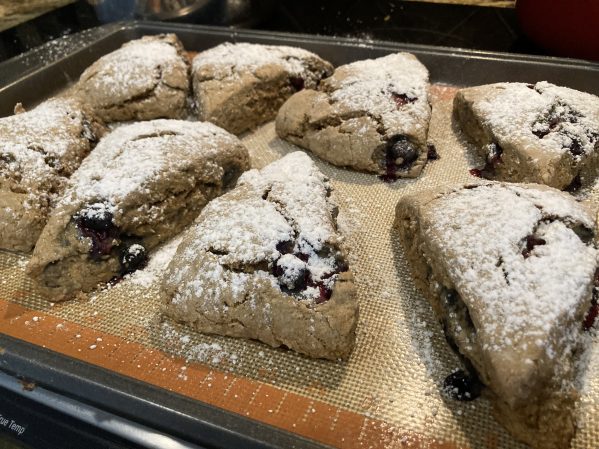
Stir fry.
Roasted veggies.
Soups like minestrone.
Spaghetti.
Gotta figure out pizza.
And big, delicious salads (for me!) every day for lunch. Which I eat anyway. Instead of tuna on my salad I’ll eat chickpeas, sunflower seeds, olives, and my homemade vinaigrette. I really love my daily salads.
Snacks? Walnuts, fruit (oranges, bananas, berries, apples), peanut butter (Little ThreeYear is allergic to almonds), Mr. ThreeYear’s homemade bread, tortilla chips and salsa.
We still have to stick with our $600 per month budget, so we will have to slowly replace our staples–sugar, egg replacement, Earth Balance margarine.
I like Dr. Greger’s recommendation to check off his “Daily Dozen”–twelve categories that will fill your body up with major antioxidants and vitamins and minerals–and then not worry so much about the rest.
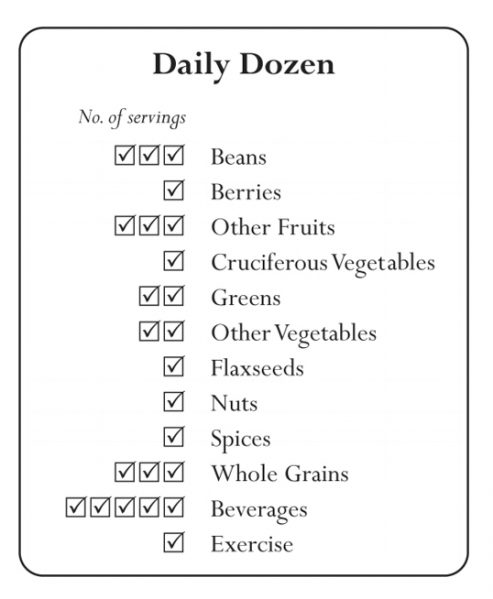
Weight Control
So what about weight control? After all, we were about to go on the Keto diet when all this started.
Well, I was reassured by Greger’s statistics that of all the different dietary groups studied, vegans had the lowest percentage body fat. Your BMI (body mass index) is a measure of how much fat you have, taking your height into account. You want your BMI to be between 18.5 and 24.9. Anything over 25 is overweight, and anything over 30 is obese.
What’s my BMI? Ugh, truth time. Currently it is anywhere between 24.5 and 24.9. Man, I am hovering at the Overweight line.
So isn’t it healthier to be a lower weight than to eat vegetables? Short answer, no. Long answer, you will be if you go on and stay on a primarily plant-based diet.
I know that since the beginning of school, when I have been eating a big salad for lunch almost every day, I have naturally shed 3-4 pounds. Hopefully with this new way of eating that will happen as well.
The book states, “the largest study ever to compare the obesity rates of those eating plant-based diets was published in North America. Meat eats topped the charts with an average BMI of 28.8–close to being obese. Flexitarians (people who ate meat more on a weekly bases rather than daily) did better at a BMI of 27.3, but were still overweight. With a BMI of 26.3, pesco-vegetarians (people who avoid all meat except fish) did better still. Even US vegetarians tend to be marginally overwight, coming in at 25.7. The only dietary group found to be of ideal weight were the vegans, whose BMI averaged 23.6.”
Interesting.
What about the kids? Don’t they need meat for protein? Apparently not. There is so much protein in beans, cruciferous veggies, nuts, and other food, that they can get all the nutrients they need with just plants. I’m sure they will continue to eat meat occasionally, anyway.
I will follow up with some posts of recipes we have been trying.
I’ll also follow up with some posts of how much we are spending on groceries.
And, of course, posts about how we are human, and inevitably messing up and failing at this way of eating.
That is where we are on this day. If you’re curious, check out the book or Dr. Greger’s site, NutritionFacts.org.
Have you ever been inspired to change your diet?
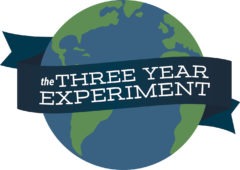
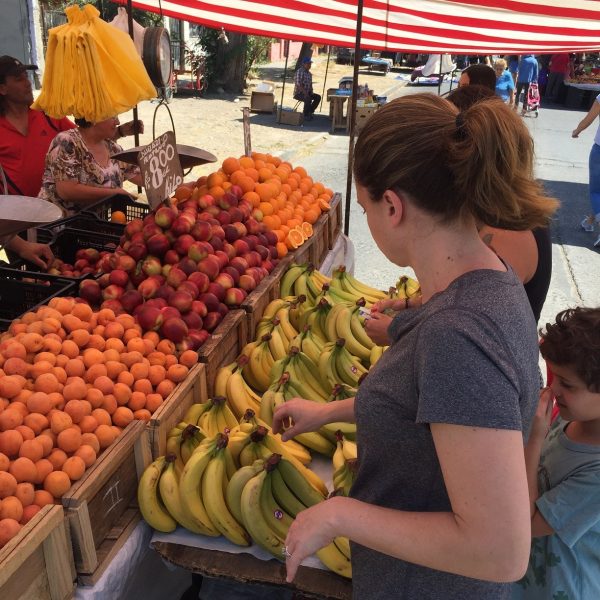

This makes me smile – I discovered the same book recently during a free trial to Kindle Unlimited and I devoured it! Then I blogged about it. (Here I link to the post directly.) But your post is WAY more detailed and informative than mine so I’ll go back and look for a place to link to yours. So true about the bowel stuff, plus I feel healthier and stronger eating this way. Garbanzos and beans are giving me just as much protein as meat was. I get EXCITED when I remember to include cruciferous vegetables in my meal plan. 🙂 My goal is to eat this way entresemana and on the weekends let myself have some good quality meat and fish.
Dina,
Great review! I love the link for vegetarian chili. I have yet to find a recipe that I love so I will definitely check that out. I also love the point you make about the book getting you excited about something, instead of fear-mongering or lecturing. I agree that it’s a much more effective way to get people to change their behavior. That’s a great plan to eat vegan during the week. Junior ThreeYear suggested the same thing. Here’s to cruciferous vegetables! 🙂
Thanks for this post, Laurie! I can’t wait to hear the budget impacts and most especially the recipes (can you start with the pumpkin & bean stew?)! Sharing that checklist is particularly helpful. I’ve copied it down to give me a daily reference point. This reminds me I’ve got several cartons of almond milk that need to be used up for baking, and I got a copy of Veganomicon at the library booksale last month for $2. I’m wondering if you might take a look at Mark Bittman’s VB6 and let us know what you think?
Sarah, yes! I will definitely post those soon. I am glad the checklist was helpful. I need to print it out and put it on my fridge, too, for a daily visual. I will definitely check out VB6! Thanks for the tip. I love Mark Bittman and I’ve always been intrigued by his vegan-during-the-day philosophy but have never checked it out!
I enjoyed your post since I find myself in the same boat! I try so hard to be a healthy eater and a vegetarian but inevitably end up eating a little meat each week, having a bread-heavy day or two, and a sugar-overload day! Ugh… it’s a constant struggle. I also limit my eating window on most days to @10 hours (‘fasting’ the other 14- and feel sooo good from adopting that habit).
I’d love to know your vinaigrette recipe and the pumpkin/bean stew.
I’ll trade you some authentic Indian recipes! My hubs is Indian and I’ve gotten some great recipes from his Mom over the years!
Barbara,
It’s a deal! Post going up very soon! You know, I feel you on the constant struggle. It is not easy to eat “clean” or whatever you want to call it, especially when we’re surrounded by people/advertisements/fast food restaurants urging us to eat the SAD (Standard American Diet). I have been a faster for a long time too and it has seemed to really work for me, although I am starting to eat breakfast now. Can’t wait for those Indian recipes. That is gold!